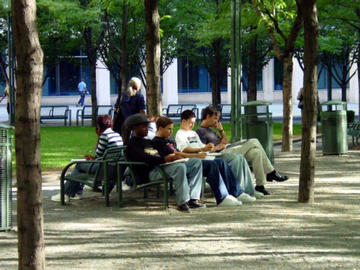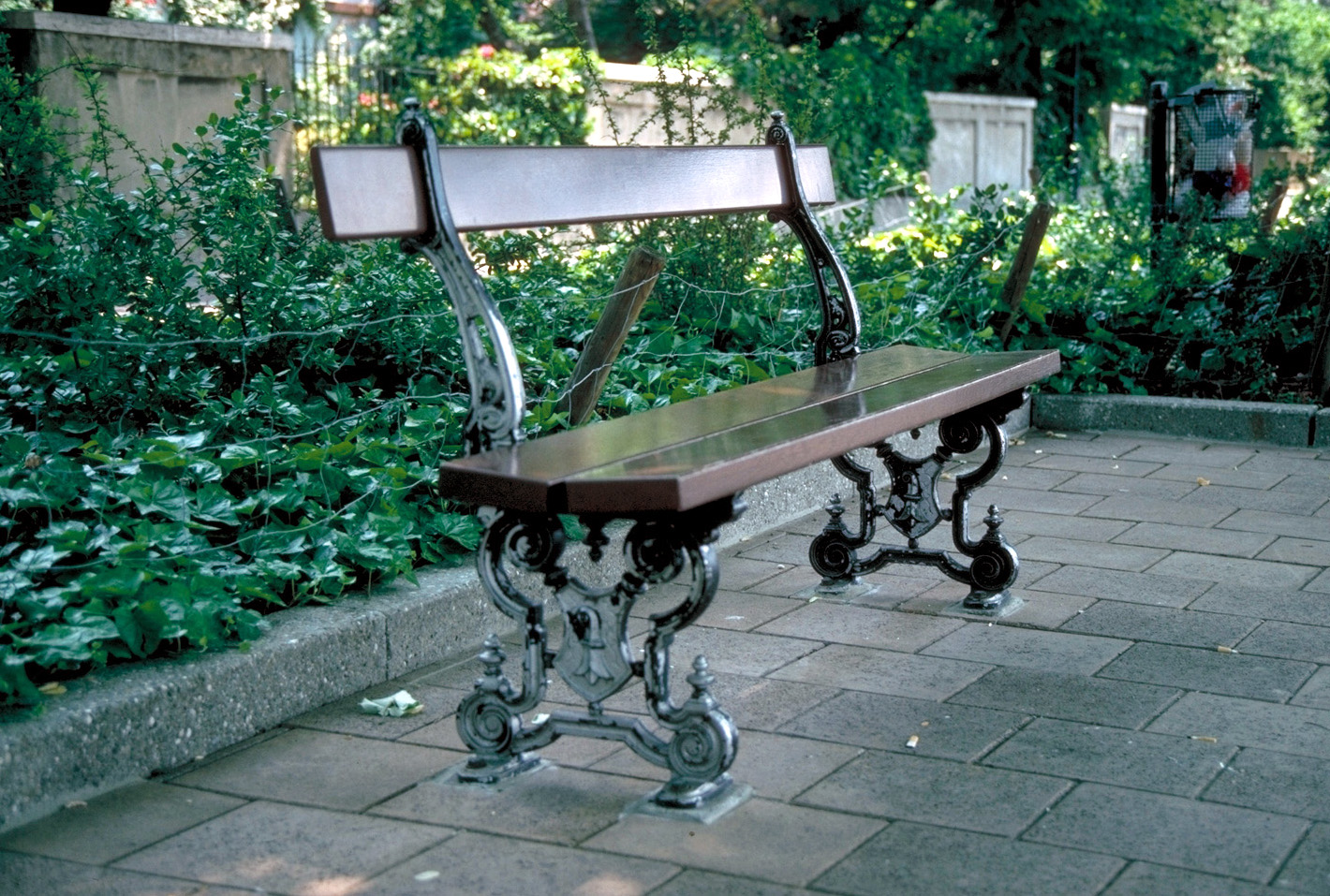A biweekly newsletter with public space news, resources, and opportunities.
A curated dispatch on all things public markets plus the latest announcements from the Market Cities Program.
Probably the best kind of seating is the movable chair. Not perfect in every situation, it is nearly so in most. Why? Several reasons. Firstly, chairs are more comfortable than benches. Secondly, they're inexpensive. Costs vary, but you can provide roughly 10 movable chairs for the price of one bench (or even less).

Thirdly, people can arrange chairs how they like, to sit nearer or farther apart, and move them around to either sun or shade (click on the video clip above to see movable seating in action). This choice allows people to exercise their options to sit near an event, or away in the quiet, wherever they may feel more comfortable. Many times, they will leave them right where they are, or move them just a few inches. Notable examples of movable seating can be found in Paris's Luxembourg Gardens and New York City's Bryant Park.
Certainly, providing movable furniture opens up the possibility that it might be stolen. However, if the area is supervised by an attendant, or if the furniture is located near another amenity or activity where staff is present, then vandalism and theft become much less likely (Bryant Park reports that just a few of its hundreds of movable chairs are stolen each year). See below for examples of movable chairs in action.




Excerpted from Public Space Amenities: A Guide to their Design and Management in Downtowns, Neighborhood Commercial Districts, and Parks, published by Project for Public Spaces.

A well-designed bench in the right location can be a real hub of activity along a sidewalk. Even though the primary purpose of a bench should be the convenience and comfort of the person using it, many benches are not used because they are cold, hard, uncomfortable, or located in the wrong place.
Unfortunately, in many cities, benches are also the source of problems. For example, benches located in isolated areas sometimes are subject to vandalism or are used as places to sleep. These problems usually occur because one or more of the following mistakes are made. One mistake is thinking that more is better. All too often, many more benches are purchased than are actually needed. Another mistake is that benches are often placed at regular intervals along a street rather than in relation to how they will be used, or without considering how the bench will function in relation to adjacent land uses and other amenities along the street. To avoid making these common mistakes some important initial questions must be asked.
The most important decision that needs to be made in selecting a bench, or any other type of public space amenity, is whether it is needed and whether it will be used. This requires visiting the area and noting the types of seating that already exist; the types of land uses (e.g., shops, offices, residences) that are along the street; and the potential clientele (e.g., office workers, shoppers) in the area who would be likely to use the benches. Locations where people already sit (on steps, ledges, etc.) should also be noted. This type of on-site observation is important in making decisions about where, how many, and what types of benches are needed.

Locations for benches are places where there are people - places where people wait for rides, taxis or buses; outside department stores and office building entrances; near food shops; and anywhere that people can watch other people. Bad locations are places where there is little activity, such in front of banks that close early, buildings without windows, places that are hidden from view or located too far from activity. Once a decision has been made about the general location, the following guidelines can be used in positioning benches along a street:

Comfort is an important factor in designing a bench. But how comfortable a bench needs to be depends on how it will be used. For example, on a shopping street where people will stop briefly with packages, comfort is not as important as in a park where people may spend an entire afternoon. Concern for comfort must be combined with other considerations. For example, in an area where teenagers may sit on the backs of the benches, a bench with large slats, which is stronger, should be used, even though for sitting large slats are less comfortable than smaller ones. The general lesson to be kept in mind is that all factors must be considered together in choosing or designing a bench for a particular location.
A second factor in bench design is appearance. It is important that a bench fits in with its surroundings. The reason for this is that a bench, which appears to be an extension of the property it sits next to, will help to give a proprietary feel to the street. This increases the likelihood that business owners will take care of the bench (and the street) that will, in turn, have a positive effect on safety and security in the area.
The following design guidelines can be used in designing or selecting a bench that is suitable for most situations:

The Seat
The Back
The Legs
Armrests
Benches should be constructed of durable materials that are resistant to weather, vandalism, and rusting. Benches can be made of concrete, wood, iron, steel, and fiberglass, but the most comfortable and durable material is wood.
If wood is used, the parts that most often require replacing are the slats. Slats should be stockpiled, or a bench manufacturer should be selected that has slats that can be reordered quickly.
Painting slats and supports requires time and funds. Some ways around painting are: using aluminum for supports; galvanizing steel supports before painting; staining instead of painting slats; and using concrete (such as in concrete standard or wall hung benches) to avoid corrosion or rust.
Using slats that are the same size aids in replacement and labor costs. Bench seating, for example, can be more economical by using as few as two different slats in one bench. Slat replacement can be made easier by the way it is attached to the bench structure and tradeoffs may need to be considered between ease of replacement and frequency of replacement. For example, a rod through a contour bench requires more time to be replaced than using bolts directly to the bench structure. However, the rod attachment is stronger and so it does not have to be replaced as often as using bolts.
Installation should be inexpensive, time efficient, and durable as possible. Installation plans should allow for experimentation with location, and bench arrangement.

Because many cities are not adequately staffed for a good bench maintenance program, benches are sometimes left derelict and broken benches are left in disrepair. This problem is magnified when people see the neglect and then make generalizations that influence their perceptions or feelings about the entire downtown.
Sometimes benches are vandalized. There is no bench that is vandal resistant. However, being aware of the likelihood of vandalism in particular areas can affect the type of bench selected for that area. The best solution to vandalism lies not in the type of bench used, but in developing an understanding of what types of vandalism occur, at what times, by what types of people, and then in trying to develop a program that will prevent it from occurring. The key to preventing vandalism in a downtown is locating benches where adjacent storeowners will assume some responsibility for their use and maintenance.
More public space amenities resources? Check out our furnishing your public space resource.
The rich text element allows you to create and format headings, paragraphs, blockquotes, images, and video all in one place instead of having to add and format them individually. Just double-click and easily create content.
The rich text element allows you to create and format headings, paragraphs, blockquotes, images, and video all in one place instead of having to add and format them individually. Just double-click and easily create content.
Body Text Body Link
The rich text element allows you to create and format headings, paragraphs, blockquotes, images, and video all in one place instead of having to add and format them individually. Just double-click and easily create content.
Here is some highlighted text from the article.




Headings, paragraphs, blockquotes, figures, images, and figure captions can all be styled after a class is added to the rich text element using the "When inside of" nested selector system.
Headings, paragraphs, blockquotes, figures, images, and figure captions can all be styled after a class is added to the rich text element using the "When inside of" nested selector system.
Headings, paragraphs, blockquotes, figures, images, and figure captions can all be styled after a class is added to the rich text element using the "When inside of" nested selector system.

We are committed to access to quality content that advances the placemaking cause—and your support makes that possible. If this article informed, inspired, or helped you, please consider making a quick donation. Every contribution helps!
Project for Public Spaces is a 501(c)(3) tax-exempt organization and your donation is tax-deductible within the guidelines of U.S. law.